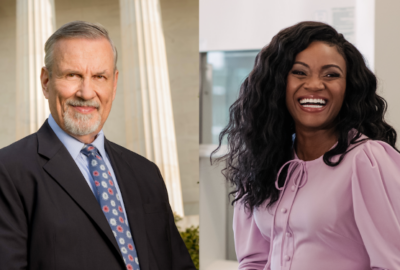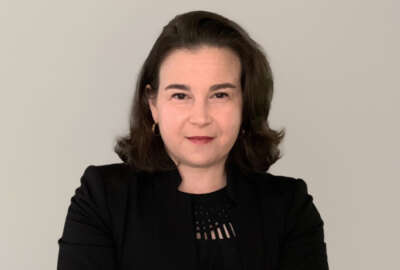Hubbard Radio Washington DC, LLC. All rights reserved. This website is not intended for users located within the European Economic Area.
How one agency made sure vaccines and other COVID medicines reached the poor and underserved
When the government spent billions on health measures in response to the pandemic, officials worried whether enough would flow to the poor and vulnerable. Such ...
Best listening experience is on Chrome, Firefox or Safari. Subscribe to Federal Drive’s daily audio interviews on Apple Podcasts or PodcastOne.
When the government spent billions on health measures in response to the pandemic, officials worried whether enough would flow to the poor and vulnerable. Such people live in both urban and rural areas. This guest on the Federal Drive with Tom Temin coordinated the work to get millions of vaccines and other medications to community health centers. She’s the director of the Office of Quality Improvement at the Health Resources and Services Administration, and a finalist in this year’s Service to America Medals program, Dr. Suma Nair.
Interview transcript:
Tom Temin: Dr. Nair Good to have you on
Suma Nair: Good morning.
Tom Temin: Let’s talk about that idea of community-based health centers. Because in the larger sense of the words, every health care center is in a community of some type. What were you actually targeting here?
Suma Nair: This program was run through the Health Resources and Services Administration. And we provide grants to community health centers, 1,400 organizations all across the country, and the territories, they have over 13,000 service delivery sites as well. Basically, they’re community-based patient directed organizations that provide access to affordable, accessible primary health care services to folks all across the country. They serve over 29 million patients living in the United States. 90% of our patients are at or below 200% of the federal poverty level, over 60% are racial ethnic minorities, and almost a quarter are best served in a language other than English.
Tom Temin: Wow. So the grants then are to actually keep the places open and operating? That’s the main source of revenue?
Suma Nair: The grants are, on average, about 20% of a health center’s operating budget. They also get reimbursement through public insurance, other grants, we provide grants exactly, as you said, for primary care services. A lot of our grant funding goes to support the workforce of the health center who provide those health care services.
Tom Temin: Got it. So it didn’t go to places like Brigham and Women’s and rich, well funded, that are attended by people of means pretty much.
Suma Nair: Right. Nope. These are community-based organizations that are there to serve individuals who are medically underserved in communities across the country.
Tom Temin: All right, and tell us more about the program to make sure that all of these vaccines when they did become available, but before that there were other measures and supplies and so forth that needed to get out. What was your indication of the fact that they didn’t have them? And how did you go about making sure they did have them?
Suma Nair: Yeah, early on in the response, as vaccines became more broadly available beyond the initial indications for health care workers, we started to get a sense very early on that health center workforce weren’t being vaccinated, and they didn’t have access to the vaccine. And then furthermore, plans were to scale large community vaccination events, really to get through, you know, high volumes of folks, which was critically important at the time, it became clear to us that what about the individuals who would never show up for those who could never go through a mass vaccination drive-thru clinic show up at a local pharmacy? What were we going to do to support them and get to them, educate them about the availability of the vaccine, educate them on any questions or concerns they had about the vaccine, and then support them in getting their first dose and their second dose in those primary series. And so that really was, I think, the impetus for the administration to set up this program to have a direct supply of vaccines to health centers who have long standing relationships with their communities and the patients that they serve. And so they knew where these individuals were and how to access them, because of that trusting long term health care relationship that they had built up. So when health centers had access to the vaccine, they could bring in their patients. Remember, early in our vaccination efforts, you’d go on a website, you’d need to schedule your appointment, you’d go stand in line, those are all things when you hear about our patient population, those may not work for them. And so health centers proactively reached out to their patients scheduled them. After the initial efforts to stand up really quick mass vaccination within the health center context, which is accessible, it’s in their own community, there are sites everywhere. They then, they, health centers, then took the opportunity to go out into the community. So when they got through the initial group of who wanted vaccines, they partnered with community-based organizations, faith-based organizations, when it was time schools to go out and vaccinate individuals.
Tom Temin: We’re speaking with Dr. Suma Nair. She is director of the Office of Quality Improvement at the Health Resources and Services Administration, HRSA and a finalist in this year’s Service to America Medals program. And was it important to get the employees and health care workers at these community centers vaccinated first, to increase their ability to receive more people and deal with them and therefore maybe have greater throughput in the center’s?
Suma Nair: Absolutely, I think, you know, it’s essential that we vaccinated all of our health care workers and health centers equally important. They’re the first line of defense in many cases for their patients. When their patients don’t feel well or have questions, they come to a health center. You know, health centers across the country played an important role early in the pandemic of trying to help people understand the mitigation efforts, what precautions they needed to take, so that they didn’t get very sick. And they didn’t have to go to the hospital. So especially at a time where ERs were starting to overflow, it was important for health center providers to help patients who maybe weren’t feeling well. But were not bad enough to go to a hospital yet, stay at home, isolate and take care of themselves so that they didn’t have to appear at the hospital.
Tom Temin: And in the pre-vaccine part of the pandemic, which was, I guess, most of 2020. Now, if I can recall the calendar here, were you also involved in getting other types of supplies or whatever treatments were thought to be useful to the same centers?
Suma Nair: Yeah, absolutely. I think early in the pandemic, as we were noticing the lack of access to personal protective equipment, some of the challenges folks were facing across the country, we jumped into action to get a better sense of what was happening in our communities across the country. So we developed a survey to get a sense of what was the implication of the pandemic, closures access to PPE, etc. on our health centers, as organizations in certain places, were they not, you know, some had school-based health center sites, they obviously weren’t seeing any patients there. What were the impact on the health center staff, they also were getting infected, they had to take care of their patients, they had to take care of their families, right as children were out of school. So the impact on health center staff, also challenges they had with obtaining PPE, there were still patients who still needed access to primary care, right, managing chronic diseases and other things. And so what health centers then did to flip the way they delivered care from in person to virtual. There’s a 6,000% increase in their ability to provide virtual visits in 2020. So continuing to provide critical access to care, just in a different modality.
Tom Temin: Spoken truly like a HRSA person, they’re on that last percentage. And we’re there’s some logistics issues, because in the rural areas, it might have been difficult to get these things physically shipped, whereas you could put them in a taxi cab for a poor neighborhood in New York City, for example.
Suma Nair: Yeah, exactly. So the vaccines, you know, they were fragile, right? They had very specific requirements around how to handle the vaccines. And I think early on, there were some questions, hey, these community-based organizations, do they have the large scale freezer capacity and all the things that were necessary to handle vaccines and health centers to their credit, and using some of the COVID response dollars, they did have access, they did partner with organizations so they could get these vaccines, keep them at the right temperature and share them. You know, it’s an interesting point about the smaller, maybe more rural organizations who needed access. As we work through our program, one of the concerns that they faced, you know, we regularly checked in with our health centers, and they said, we really want to vaccinate, I can’t take 1,000 doses, they were coming in trays of 1,100. I don’t have as many individuals who will come for care. But I still am a critical point of care for these individuals. So we set up a program within health centers where one hub health center would receive them, they break down the doses, and then they’d partner and get them out to the other ones, so that we could expand access into our smaller and more rural communities.
Tom Temin: And because you are a Sammies finalist, I just wanted to ask you about your own career briefly and how you came to this particular type of work.
Suma Nair: Yeah, it was happenstance I have to say after graduate school, I have a background in public health, nutrition. And so always worked in a team of individuals focused on health care. I had the opportunity to join HRSA as a HRSA scholar, something like a President Management Fellowship, and got an opportunity to learn about the HRSA’s different programs, and eventually, over time, focused on performance improvement, quality improvement, that kind of work. And then I landed up in the health center program, in HRSA, working in the quality and data shop. So I think the experiences in data using systems and technology, we also do partnerships. So partnering with our state-based organizations, our national organizations, and building a relationship with health centers focused on quality improvement over the last 15 years, made it one, a no brainer, we saw that health centers weren’t getting access. And so when we were presented with an opportunity, we were going to figure out a way no matter what, as quickly as possible. And then I think that trusted relationship with the health centers on the other side, because as they say, right, you can build it, but if they don’t come and utilize it, it’s kind of a waste. And so it was a fair amount of work on the health centers for sure. But because of our trust relationship, they came along, they were working nights and weekends to make sure they could access the vaccine, get it out, share the data back. And that really, I think that relationship from start to finish is what had us be very successful in this endeavor.
Tom Temin: You like your work, don’t you?
Suma Nair: Clearly.
Tom Temin: Dr. Suma Nair director of the Office of Quality Improvement at the Health Resources and Services Administration and a finalist in this year’s Service to America Medals program. Thanks so much for joining me.
Suma Nair: My pleasure. Thank you for having me.
Copyright © 2024 Federal News Network. All rights reserved. This website is not intended for users located within the European Economic Area.
Tom Temin
Tom Temin is host of the Federal Drive and has been providing insight on federal technology and management issues for more than 30 years.
Follow @tteminWFED





